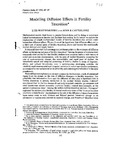Mostrar el registro sencillo del ítem
Modelling Diffusion Effects in Fertility Transition
| dc.creator | Rosero Bixby, Luis | |
| dc.creator | Casterline, John B. | |
| dc.date.accessioned | 2015-07-24T16:54:17Z | |
| dc.date.available | 2015-07-24T16:54:17Z | |
| dc.date.issued | 1993 | |
| dc.identifier.citation | http://www.tandfonline.com/doi/abs/10.1080/0032472031000146786#.VbJdJ_lViko | |
| dc.identifier.issn | 0032-4728 | |
| dc.identifier.issn | 1477-4747 | |
| dc.identifier.uri | https://hdl.handle.net/10669/15109 | |
| dc.description | Artículo científico-- Instituto de Investigaciones en Salud-- 1993 | es_ES |
| dc.description.abstract | Mathematical models bind theory to precise formulations, and by doing so accentuate logical inconsistences in theories and facilitate their testing. In this article we explore the implications of simple mathematical models of fertility transition that contain social interaction diffusion effects. We put forward the hypothesis that diffusion effects act as a third type of causal agent of fertility transition, above and beyond the traditionally studied demand and supply factors. Substantial historical and contemporary evidence points to the existence of diffusion effects on the timing and pace of fertility transition.' Among the pieces of evidence most commonly cited are the fact that fertility declines have occurred under a wide variety of social and economic circumstances, with the pace of decline frequently outpacing the rate of socio-economic change; the irreversibility and rapid pace of decline; the remarkable spatial and temporal patterning of fertility decline in terms of linguistic, ethnic, and cultural boundaries; and, in contemporary developing societies, the relatively small cross-societal and temporal variation in stated reproductive preferences, as compared to the variation in levels of fertility and contraceptive behaviour in the same populations. | es_ES |
| dc.description.sponsorship | Universidad de Costa Rica. Instituto de Investigaciones en Salud | es_ES |
| dc.language.iso | en_US | es_ES |
| dc.source | Population Studies 47:147-167 | es_ES |
| dc.subject | fertility transition | es_ES |
| dc.subject | diffusion effects | es_ES |
| dc.subject | modelling diffusion | es_ES |
| dc.subject | models of fertility transition | es_ES |
| dc.title | Modelling Diffusion Effects in Fertility Transition | es_ES |
| dc.type | artículo original | |
| dc.identifier.doi | 10.1080/0032472031000146786 | |
| dc.description.procedence | UCR::Vicerrectoría de Investigación::Unidades de Investigación::Ciencias de la Salud::Instituto de Investigaciones en Salud (INISA) | es_ES |


